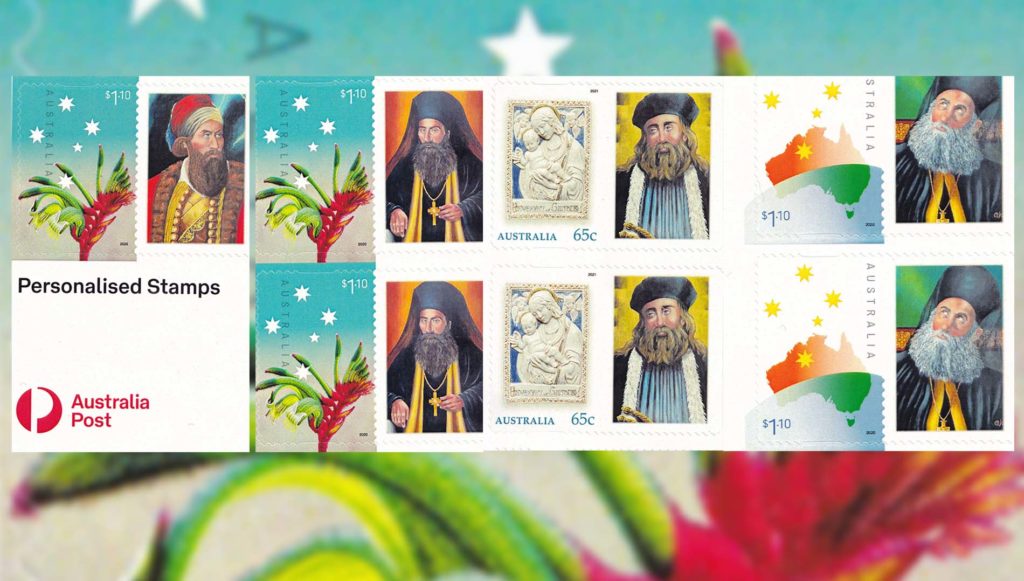
Commemorative bicentennial stamps honoring Greece’s War of Independence in 1821 are being issued by the Australia Post in collaboration with the Holy Archdiocese of Australia.
The series comprises four stamps, which depict four heroic clerical figures of the Orthodox Church, who fought for the freedom of Greece from its Ottoman overlords exactly 200 years ago.
The portraits were created by Greek artist Angela Konstantinopoulos especially for the issuance of the stamps.
The Greek Bicentennial stamps depict four men who were instrumental in the fight against the Ottoman Empire, including: Patriarch Gregory V, who was martyred and who is now a saint in the Orthodox Church; Metropolitan Palaion Patron Germanos; Bishop Isaiah of Salona; and Archimandrite Grigorios Dikaios-Flessas (Papaflessas).
Bicentennial Stamps honor clergymen who devoted their lives to the Revolution
All those who are interested may purchase the anniversary stamps from Australian Post Offices as well as from the bookstores of the Holy Archdiocese of Sydney and Melbourne. They will soon be available for purchase online for those around the world who would like to take advantage of this opportunity to commemorate the momentous event of the Greek bicentennial.
See also: Greek Office Issues Stamps Honoring Great Philhellenes
Metropolitan Germanos, who blessed the Revolution
This bishop of the Orthodox Church was one of the seminal figures of the Revolution. On March 13, 1821 Metropolitan Germanos of Old Patras (Palaion Patron Germanos) declared war at Agia Lavra Monastery, blessing the efforts of the freedom fighters.
When Palaion Patron Germanos raised the flag with the cross and blessed it, he signified that this was not only a war for freedom, but also a war of faith.
The slogan was “Liberty or Death” and the Greeks, who had been organizing their forces for months, went into the War of Independence with only that in mind.
Patriarch Gregory V, martyr of the Revolution
By January of 1822 the entire Moreas region was liberated and became Greek territory once again.
The news that the Greeks had revolted naturally infuriated the Ottomans. In the seat of the Ottoman Empire, Constantinople, the Sultan ordered the massacre of the city’s Greek population in retaliation for the Greek victory.
The Patriarch of the Greek Orthodox Church, Gregory V, was hanged in public like a common criminal — despite the fact that he had condemned the revolution and preached obedience to the Sultan. He was martyred on April 10, 1821, at the main Gate of the Patriarchate of Constantinople.
Georgios Dimitrios Dikaios (“Papaflessas”) convinced many to join War effort
Georgios Dimitrios Dikaios, better known by the nom de guerre “Papaflessas,” was perhaps the most eccentric personality of all the men and women who fought in the Revolution.
Papaflessas was not only a clergyman but a brave warrior with a magnetic personality with incredible leadership skills. He was one of the very first to raise his rifle and shout “Liberty or Death.”
A leading member of Filiki Eteria, Panagiotis Sekeris had described him as “impetuous.” Papaflessas justified this at every opportunity
At the same time he was a womanizer and hard drinker who lived a life of debauchery, completely unfit for a man of the cloth. Born Grigorios Dikaios in Messinia of Morias (today Peloponnese) in 1788, he was the son of Dimitrios Dikaios, a man who had fathered 28 children.
Using intrigue and outrageous plots, Papaflessas travelled all over Morias, using his priesthood to convince people to start the rebellion.
Because of his sincere love for his country, he managed to enlist a sizable number of people to form an army of devoted soldiers.
Papaflessas and his men fought in many battles in Morias, stopping the army of Omer Vrioni in Corinth and Argolis until the end of 1821.
In 1822, along with Theodoros Kolokotronis, Papaflessas fought the mighty army of Dramali Mahmud Pasha who came from Larissa to suppress the revolution in Morias.
Isaiah of Salona first clergyman to die in Greek War of Independence
This priest was the first man of the cloth to die for his homeland in the Revolution.
Isaiah (whose real name was Elias) was a great patriot who sacrificed himself to spark patriotism for the Greek cause.
Born in Desphina of Delphi, in 1818 Elias was appointed bishop of Salona, taking the name Isaiah. He was initiated into the Society of Friends (Φιλικὴ Ἑταιρεία) and began gathering large sums of money as well as weapons for the war effort.
On March 27, 1821, Isaiah of Salona hoisted the Greek flag signaling the outbreak of the Greek War of Independence in Viotia.
Isaiah next fought in the Battle of Alamana. He led into battle the outnumbered Greeks against the more formidable army of Omer Vryoni on April 23, 1821. He then fell heroically after ordering his soldiers to leave him wounded and save themselves. The next day, Athanasios Diakos was impaled alive by the Turks; alongside him were also impaled the heads of fallen Greeks — among them that of Bishop Isaiah of Salona.
Related posts:
Views: 0
 RSS Feed
RSS Feed

















 December 2nd, 2021
December 2nd, 2021  Awake Goy
Awake Goy 
 Posted in
Posted in  Tags:
Tags: 
















